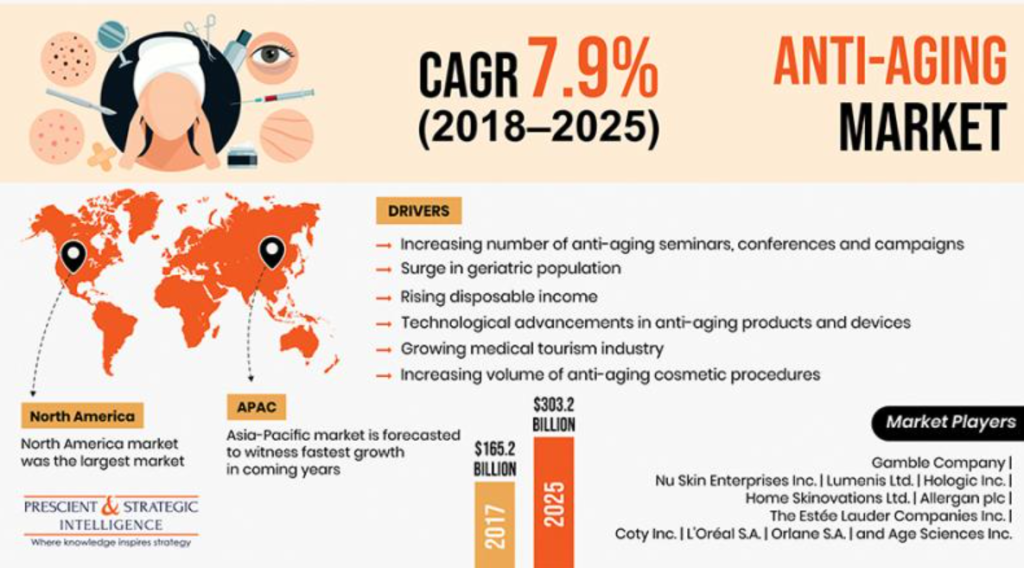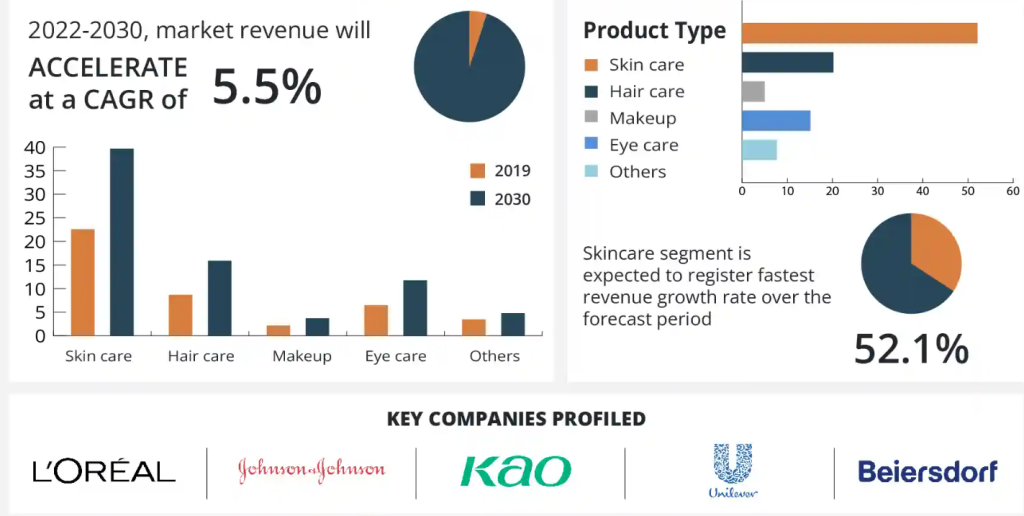
The anti-aging market has witnessed consistent growth due to the aging global population and the increasing desire among consumers to maintain a youthful appearance. The market encompasses various product categories, including skincare, haircare, supplements, and advanced medical treatments and procedures.
The global anti-aging market is expected to grow from USD 66.7 billion in 2022 to USD 120.23 billion by 2030, at a CAGR of 7.5% during the forecast period. The growth of the market is attributed to factors such as the rising aging population, increasing disposable income, and growing awareness about the benefits of anti-aging products and treatments.

Key Trends in the Anti-Aging Market
Some of the key trends in the anti-aging market include:
- Rising popularity of minimally invasive procedures: Minimally invasive procedures such as Botox, dermal fillers, and laser skin resurfacing are becoming increasingly popular, as they offer effective results with minimal downtime.
- Growing demand for personalized anti-aging solutions: Consumers are increasingly looking for personalized anti-aging solutions that are tailored to their individual needs and concerns. This is leading to the development of new products and treatments that are targeted at specific skin types and conditions.
- Increasing popularity of natural and organic anti-aging products: There is a growing demand for natural and organic anti-aging products, as consumers become more aware of the potential health risks associated with synthetic ingredients.
- Rising adoption of anti-aging technologies: New technologies such as artificial intelligence (AI) and machine learning (ML) are being used to develop innovative anti-aging products and treatments. For example, AI-powered skin analysis devices can help consumers to identify their skin concerns and choose the right anti-aging products.
Major Key Players in the Anti-Aging Market

Some of the major key players in the anti-aging market include:
- Allergan
- Johnson & Johnson
- L’Oréal
- Procter & Gamble
- Unilever
- Shiseido
- Estée Lauder Companies
- Coty
- Beiersdorf
- Merz Group
- Galderma
Forecast for the Anti-Aging Market

The global anti-aging market is expected to grow at a CAGR of 7.5% during the forecast period. The growth of the market is attributed to factors such as the rising aging population, increasing disposable income, and growing awareness about the benefits of anti-aging products and treatments.
The Asia Pacific region is expected to be the fastest-growing market for anti-aging products and treatments during the forecast period. This is due to the region’s large and growing aging population, as well as its increasing disposable income.
Assuming the trajectory remains consistent with prior trends, the anti-aging market should continue its upward growth. Asia-Pacific, particularly markets like South Korea and Japan, might continue to see significant growth due to their advanced skincare markets and aging populations.
Challenges:
- Regulations: Increasingly strict regulations might challenge product claims and the introduction of new products or treatments.
- Economic Factors: Global economic uncertainties could affect disposable incomes and consumer spending on premium anti-aging products.
Opportunities:
- Emerging Markets: Regions like Southeast Asia and Latin America could present significant growth opportunities due to increasing disposable incomes and urbanization.
- Research and Innovation: Continued research might introduce new ingredients, treatments, or technologies with breakthrough anti-aging benefits.
Anti-aging Market Forcast
The global anti-aging market is expected to grow from USD 66.7 billion in 2022 to USD 120.23 billion by 2030, at a CAGR of 7.5% during the forecast period. The growth of the market is attributed to factors such as the rising aging population, increasing disposable income, and growing awareness about the benefits of anti-aging products and treatments.
The Asia Pacific region is expected to be the fastest-growing market for anti-aging products and treatments during the forecast period. This is due to the region’s large and growing aging population, as well as its increasing disposable income.
The growth of the anti-aging market is also being driven by the increasing popularity of minimally invasive procedures, the growing demand for personalized anti-aging solutions, the increasing popularity of natural and organic anti-aging products, and the rising adoption of anti-aging technologies.
1. Market Size and Growth: The global anti-aging market is expected to grow steadily. It was valued at several billion USD in 2021 and, given the consistent previous growth rate, is expected to grow annually at a compound rate of 5-7%. The exact value and CAGR would need to be sourced from 2023-specific data.
2. Drivers of Growth:
- Aging Global Population: With an increasing elderly demographic in many countries, the demand for anti-aging products and treatments will likely remain high.
- Technological and Product Advancements: New formulations, treatments, and technologies will drive consumer interest and market growth.
- Increased Consumer Awareness: A more informed consumer base, due to the rise of digital media and influencers, will likely continue to spur interest in advanced skincare and anti-aging treatments.
3. Regional Dynamics:
- Asia-Pacific Dominance: Countries like South Korea, Japan, and China, with their robust skincare markets, will likely drive significant growth in the Asia-Pacific region.
- North America and Europe: Both regions will continue to hold significant market shares due to their aging populations and high consumer spending power.
4. Segment Growth:
- Skincare Products: This segment, which includes creams, serums, and masks, will likely maintain its dominance in the market.
- Medical Treatments and Devices: With the advancements in non-invasive treatments like lasers, fillers, and botox, this segment will see robust growth.
5. Competitive Landscape:
The market will remain competitive, with major players like L’Oréal, Procter & Gamble, Estée Lauder, and Allergan continuing to innovate and release new products. However, emerging startups and brands might also capture market share by introducing disruptive technologies or unique product offerings.
6. Potential Challenges:
- Regulatory Hurdles: As governments and bodies scrutinize product claims and the safety of new treatments, companies might face challenges in product releases or marketing.
- Economic Shifts: Global economic dynamics, including potential downturns, can impact consumer spending.
7. Opportunities:
- Natural and Organic Offerings: With increasing consumer demand for clean and green products, there’s an opportunity for brands that emphasize natural and organic ingredients.
- Digital Platforms and E-commerce: Brands that leverage online platforms for sales and marketing will likely see higher growth.
List of company and their work towards Anti Aging

Allergan
Allergan is a global pharmaceutical company that develops, manufactures, and sells a variety of products, including anti-aging products such as Botox and Juvederm. Botox is a neurotoxin that is injected into the muscles to reduce wrinkles and fine lines, while Juvederm is a dermal filler that is injected into the skin to add volume and reduce wrinkles.
Johnson & Johnson
Johnson & Johnson is a multinational pharmaceutical and consumer goods company that develops, manufactures, and sells a wide range of products, including anti-aging products such as Olay Regenerist and Neutrogena Hydro Boost. Olay Regenerist is a skincare line that claims to reduce wrinkles and fine lines, while Neutrogena Hydro Boost is a skincare line that claims to hydrate and plump the skin.
L’Oréal
L’Oréal is a French multinational cosmetics company that develops, manufactures, and sells a wide range of products, including anti-aging products such as L’Oréal Paris Revitalift and Lancôme Rénergie. L’Oréal Paris Revitalift is a skincare line that claims to reduce wrinkles and fine lines, while Lancôme Rénergie is a skincare line that claims to firm and lift the skin.
Procter & Gamble
Procter & Gamble is a multinational consumer goods company that develops, manufactures, and sells a wide range of products, including anti-aging products such as Olay Regenerist and SK-II. Olay Regenerist is a skincare line that claims to reduce wrinkles and fine lines, while SK-II is a skincare line that claims to brighten and smooth the skin.
Unilever
Unilever is a British multinational consumer goods company that develops, manufactures, and sells a wide range of products, including anti-aging products such as Pond’s Age Miracle and Dove DermaCare. Pond’s Age Miracle is a skincare line that claims to reduce wrinkles and age spots, while Dove DermaCare is a skincare line that claims to moisturize and soothe the skin.
Shiseido
Shiseido is a Japanese cosmetics company that develops, manufactures, and sells a wide range of products, including anti-aging products such as Future Solution LX and Benefiance. Future Solution LX is a skincare line that claims to regenerate the skin, while Benefiance is a skincare line that claims to firm and lift the skin.
Estée Lauder
Estée Lauder Companies is an American multinational cosmetics company that develops, manufactures, and sells a wide range of products, including anti-aging products such as Estée Lauder RéVive and La Mer. Estée Lauder RéVive is a skincare line that claims to reduce the appearance of wrinkles and fine lines, while La Mer is a skincare line that claims to hydrate and protect the skin.
Coty
Coty is an American multinational beauty company that develops, manufactures, and sells a wide range of products, including anti-aging products such as Philosophy Hope in a Jar and Lancaster 365 Sun Compact. Philosophy Hope in a Jar is a skincare line that claims to reduce the appearance of wrinkles and fine lines, while Lancaster 365 Sun Compact is a sunscreen that claims to protect the skin from the sun’s harmful UV rays.
Beiersdorf
Beiersdorf is a German multinational consumer goods company that develops, manufactures, and sells a wide range of products, including anti-aging products such as NIVEA Cellular Anti-Age and Eucerin Hyaluron-Filler. NIVEA Cellular Anti-Age is a skincare line that claims to reduce the appearance of wrinkles and fine lines, while Eucerin Hyaluron-Filler is a skincare line that claims to plump and hydrate the skin.
Merz Group
Merz Group is a German multinational pharmaceutical and medical devices company that develops, manufactures, and sells a wide range of products, including anti-aging products such as Ultherapy and Belotero. Ultherapy is a non-invasive skin tightening treatment that uses ultrasound energy to stimulate collagen production, while Belotero is a dermal filler that is injected into the skin to add volume and reduce wrinkles.
Galderma
Galderma is a Swiss multinational pharmaceutical company that develops, manufactures, and sells a wide range of products, including anti-aging products such as Restylane and Dysport. Restylane is a dermal filler that is injected into the skin to add volume and reduce wrinkles, while Dysport is a neurotoxin that is injected into the muscles to reduce wrinkles and fine lines.